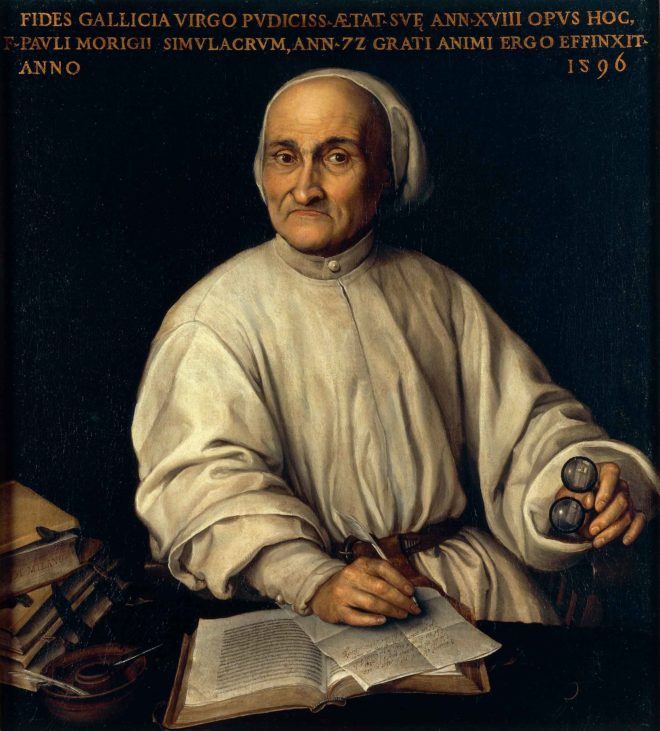À PROPOS DE L'OEUVRE: PORTRAIT DE PAOLO MORIGIA
Ce portrait de Paolo Morigia, réalisé par Fede Galizia vers 1592-95, du supérieur général des Jésuates (les Clercs apostoliques de Saint Jérôme), est remarquable pour les compétences techniques de l’artiste et a été très apprécié par le modèle lui-même, qui l’a dit était une ressemblance parfaite : « elle a une telle ressemblance avec la nature que pour plus on ne saurait demander ». L’accent n’est pas tant mis ici sur l’aspect religieux de Morigia que sur lui en tant qu’historien érudit et il convient de noter qu’il tient une paire de lunettes dans sa main droite. Le rendu méticuleusement naturaliste des objets rappelle que Fede Galizia était aussi un peintre de natures mortes. Le papier sur lequel le frère écrit porte des vers de Borgogni, qui font référence à la peinture et aux talents de peintre de l’artiste.
L’un des faits les plus stupéfiants de cette peinture est que Fede Galizia a commencé à peindre ce portrait à l’âge de quatorze ans.
À PROPOS DE L'ARTISTE : FEDE GALIZIA
Fede Galizia, mieux connu sous le nom de Galizia, (vers 1578 – vers 1630) était un peintre italien de la Renaissance de natures mortes, de portraits et d’images religieuses. Elle est particulièrement connue comme peintre de natures mortes de fruits, genre dans lequel elle fut l’une des premières praticiennes de l’art européen.
Fede Galizia est née à Milan vers 1578. Son père, Nunzio Galizia, également peintre de miniatures, s’était installé à Milan depuis Trente. Fede a appris à peindre de lui. À un jeune âge (adolescente), Galizia était déjà une portraitiste établie manipulant de nombreuses œuvres de commande. Son père a peut-être été inspiré pour former sa fille par l’exemple de Sofonisba Anguissola, originaire de Crémone, à environ 80 kilomètres de Milan. C’est peut-être l’influence de son père en tant que miniaturiste qui a conduit Galizia à porter une attention particulière aux détails dans ses portraits. Son traitement des bijoux et des vêtements fait d’elle une portraitiste très recherchée. Elle a souvent été chargée de peindre des thèmes religieux et profanes. Elle a également créé des miniatures et des retables pour les couvents. Soixante-trois œuvres ont été cataloguées comme les siennes, dont 44 natures mortes. Pourtant, on ignore le nombre de tableaux exécutés par Galizia. De nombreuses œuvres qui auraient pu être les siennes ont été attribuées à son homologue masculin Panfilo Nuvolone, qui s’est beaucoup inspiré de Galizia. Ses peintures n’ont reçu la reconnaissance qu’elles méritaient qu’au début du XXe siècle, lorsqu’une attention particulière a été accordée à son travail dans des études réalisées en 1963 et 1989.
Galizia ne s’est jamais mariée ni n’a eu d’enfants, laissant à la place ses objets de vie à une cousine, Anna Galizia et à un neveu, Carlo Henrico. Le 21 juin 1630, elle fit son testament et serait morte de la peste à Milan peu de temps après, à 52 ans.
about the artwork :
PORTRAIT OF PAOLO MORIGIA
This portrait of Paolo Morigia, made by Fede Galizia around 1592-95, of the superior general of the Jesuates (the Apostolic Clerics of Saint Jerome), is remarkable for the artist’s technical skills and was much praised by the sitter himself, who said it was a perfect likeness: “it bears such a resemblance to nature that for more one could not ask”. The emphasis here is not so much on the religious aspect of Morigia as on him as an erudite historian and it is worth noting that he is holding a pair of glasses in his right hand. The meticulously naturalistic rendering of the objects reminds us that Fede Galizia was also a painter of still lifes. The paper the friar is writing on bears verses by Borgogni, which refer to the painting and to the artist’s painting skills.
One of the most amazing fact of this painting is that she began painting this portrait at the age of fourteen.
ABOUT THE ARTIST:
fede galizia
Fede Galizia, better known as Galizia, (c. 1578 – c. 1630) was an Italian Renaissance painter of still-lifes, portraits, and religious pictures. She is especially noted as a painter of still-lifes of fruit, a genre in which she was one of the earliest practitioners in European art.
Fede Galizia was born in Milan around 1578. Her father, Nunzio Galizia, also a painter of miniatures, had moved to Milan from Trento. Fede learned to paint from him. At a young age (teen age), Galizia was already an established portrait painter handling many commissioned works. Her father may have been inspired to train his daughter by the example of Sofonisba Anguissola, who was from Cremona, around 50 miles from Milan. Perhaps it was her father’s influence as a miniaturist that led to Galizia’s attention to detail in her portraits. Her treatment of jewels and clothing made her a very desirable portrait painter. She was often commissioned to paint religious and secular themes as well. She also created miniatures and altarpieces for convents. Sixty-three works have been catalogued as hers, of which 44 are still lifes. Yet, it is unknown the number of paintings Galizia executed. Many works that could have possibly been hers have been attributed to her male counterpart Panfilo Nuvolone, who drew significant inspiration from Galizia. Her paintings were not given the recognition they deserved until well into the 20th century, when special attention was given to her work in studies made in 1963 and 1989.
Galizia never married or had any children, instead leaving her life items to a cousin, Anna Galizia and a nephew, Carlo Henrico. On June 21, 1630, she made her will and is thought to have died of the plague in Milan shortly afterward, at age 52.


Comments are closed.